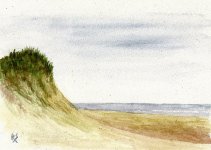@LRichard: I am a former art student (multiple disciplines, including photography and dry media), so I am familiar with representational vs. abstract vs. expressionist etc. art; I opted for a more expressionist interpretation of some of these cards because I felt it fit the theme of the card. For instance, the isolation of the Hermit is immediately obvious, as is the dangerous precipice where the Fool is joyfully playing his horn. In other cards I have planned, the subject will be much more front-and-center, much like the High Priestess here.
For the Hanged Man, the card strongly reminded me of the Odin myth, where he hung from the ash tree (it is, in fact, a tree in the painting) for nine days before achieving enlightenment, dying, and returning to life.
I can definitely see how the subject of the Hanged Man could be somewhat more apparent, and I may need to take that into account in a later iteration.
Regarding the concept of Tarot as applied art vs. pure art, I totally agree with you that the cards should be functional first, and pretty second. As I'd said earlier, though, this whole project started mostly as an artistic exercise, then evolved into a more practical experiment. I'm sure there will be many changes made to some of these cards as time goes by.
@Samweiss: I was not familiar with any of Colman-Smith's work outside of her collaboration with Waite/GD. Thank you for the link!
And thank you again to everyone for your feedback. It's often difficult to get this degree of candor from friends and family. Your comments are all appreciated!


